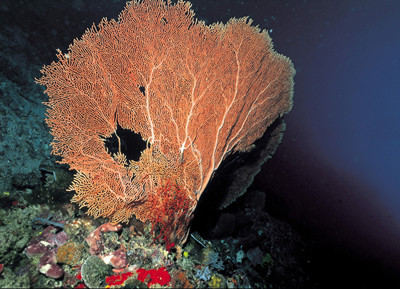The oceans are turning acidic.
海洋正在变酸。
Surface waters absorb carbon dioxide produced by the burning of fossil fuels.
表层的海水吸收由于燃烧化石燃料产生的二氧化碳。
And those CO2 molecules react with the seawater to make carbonic acid.
而后这些二氧化碳分子和海水发生反应产生碳酸。
Voila, a more acidic ocean.
瞧,一个更酸的海洋就此形成。
That's big trouble for tiny plants and animals in the sea that make shells.
这对于这片大海中生活微小的动植物外壳的产生是个大麻烦。

Because acidic water makes it harder to produce those shells.
因为海水的酸性很难产生这些壳体。
And once the shells do form, the acidic water also corrodes the shells.
并且一旦外壳形成后,酸性水也会进行腐蚀。
Many marine biologists have thus been anxious that climate change may mean an end to coral reefs.
因此许多海洋生物学家担心气候的变化可能意味着珊瑚礁的灭绝。
But a set of experiments undertaken in Hawaii, Moorea and Okinawa give new hope, at least in the Pacific.
但是在夏威夷,莫雷阿岛和日本冲绳进行的的一系列实验使得我们燃起了新希望,至少在太平洋可以。
Four common corals and algae were subjected to conditions that mimic oceans if CO2 concentrations in the atmosphere reached 1000 ppm, more than double the levels today.
在模拟海洋环境中,如果大气中的CO2浓度达到百万分之一千,也就是现如今水平2倍的话,4种常见的珊瑚和藻类就会受到影响。
And three out of the four could still easily form their hard calcium shells even in such an acid ocean.
然而4种中的3种即使在这样的酸性海洋中,也仍然可以较容易的形成硬钙质的外壳。
That doesn't mean ocean acidification won't be bad for corals and algae.
这并不意味着海洋酸化不会对珊瑚和藻类造成危害。
But it does mean that across the Pacific some of these organisms can tough it out.
但这的确表明一些横跨太平洋的生物能够坚持过去。
Whether other organisms, including us humans, could thrive in a 1000 ppm CO2 world is another question.
是否包括人类在内的其他生物,可以在浓度达到百万分之一千的CO2世界里过活也是个问题。












